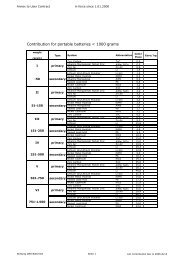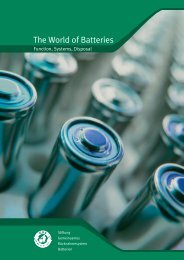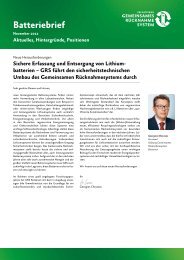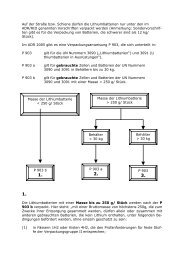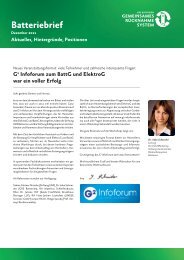You also want an ePaper? Increase the reach of your titles
YUMPU automatically turns print PDFs into web optimized ePapers that Google loves.
Stiftung Gemeinsames<br />
Rücknahmesystem <strong>Batterien</strong><br />
Heidenkampsweg 44<br />
20097 Hamburg<br />
Telefon: + 49 (0) 40 23 77 88<br />
Telefax: + 49 (0) 40 23 77 87<br />
info@grs-batterien.de<br />
www.grs-batterien.de
You and <strong>GRS</strong> <strong>Batterien</strong>:<br />
The success of a strong partnership<br />
Annual Review 2010<br />
Reporting in accordance with the Battery Act
2<br />
Table of Contents<br />
Audit certificate<br />
Foreword<br />
<strong>Our</strong> customers<br />
<strong>Our</strong> collection rate<br />
<strong>Our</strong> collection partners<br />
<strong>Our</strong> sorting operations<br />
<strong>Our</strong> <strong>recycling</strong> results<br />
<strong>Our</strong> <strong>recycling</strong> activities<br />
<strong>Our</strong> communications<br />
<strong>Our</strong> foundation<br />
Appendix (reporting pursuant to § 15 BattG)<br />
Abbreviations, definitions, sources<br />
2<br />
3<br />
4<br />
5<br />
6<br />
7<br />
8<br />
9<br />
10<br />
11<br />
12<br />
15<br />
Audit certificate<br />
Bestätigung<br />
Der Unterzeichnende hat die vorliegende Erfolgskontrolle<br />
sowie den Jahresbericht 2010 der<br />
Stiftung Gemeinsames Rücknahmesystem<br />
<strong>Batterien</strong><br />
Heidenkampsweg 44, 20097 Hamburg<br />
auf Übereinstimmung mit § 15 des Batteriegesetzes vom<br />
25. Juni 2009 (zuletzt geändert am 11. August 2010)<br />
geprüft.<br />
Da die Anforderungen des Batteriegesetzes vollumfänglich<br />
erfüllt sind und die Daten und Angaben ein<br />
verlässliches, glaubhaftes und wahrheitsgetreues Bild<br />
wiedergeben, werden die Erfolgskontrolle und der Jahresbericht<br />
2010 in der vorliegenden Fassung bestätigt.<br />
Hamburg, 18. März 2011<br />
Dr. Willi Bethäuser<br />
Umweltgutachter *<br />
Johannesstraße 15<br />
66450 Bexbach<br />
*Akkreditiert durch: DAU – Deutsche Akkreditierungs- und Zulas-<br />
sungsgesellschaft für Umweltgutachter mbH (Zulassungsnummer:<br />
DE-V-0179).
Foreword<br />
Ladies and Gentlemen,<br />
an eventful and successful year lies behind us.<br />
In 2010, we took a number of different actions<br />
to ensure that Stiftung <strong>GRS</strong> <strong>Batterien</strong> is ready<br />
to face the challenges posed by the new battery<br />
legislation into the future. <strong>GRS</strong> <strong>Batterien</strong> has<br />
nearly reached the collection rate stipulated for<br />
2016 today. But that is no reason for us to slacken<br />
our efforts. Rather, we believe it is necessary<br />
to be prepared for the markets of tomorrow by<br />
sharpening our focus on customers and enhancing<br />
efficiency.<br />
Another important point this past year was the<br />
integration of the fiduciary functions that had<br />
previously been performed by the auditing firm<br />
of KPMG and the billing of service fees into the<br />
foundation’s own organization. Faced with rising<br />
demand for service and increasing numbers of<br />
users who wished a direct customer relationship<br />
with us, we assumed responsibility for customer<br />
management ourselves effective by the end of the<br />
year. We are also focusing on the future harmonization<br />
of the European registration processes<br />
and are currently working hard to be able to offer<br />
our users a standardized registration process in<br />
the future that applies to multiple EU countries<br />
simultaneously – a step that will significantly ease<br />
the burden on all manufacturers that operate<br />
throughout Europe. The changes taking shape<br />
on the markets and the new battery systems that<br />
are now available necessitate new approaches<br />
to collecting spent batteries. Especially in light<br />
of the rapid growth of the electric mobility sector,<br />
farther-reaching collection systems will also<br />
be required in the future. A legal framework that<br />
provides for the future-proof collection of these<br />
industrial batteries was put in place last year. At<br />
the end of the year, Stiftung <strong>GRS</strong> <strong>Batterien</strong> was<br />
able to establish the first comprehensive collection<br />
system for batteries from electric bicycles,<br />
for example.<br />
Due to your trust and cooperation as our user and<br />
our service providers we are the most effective<br />
collection- and <strong>recycling</strong> system for spent batteries<br />
in Europe. This stands for our collection at<br />
retail, municipalities as well as industry.<br />
I would like to thank the contributors who have<br />
made this possible.<br />
Sincerely,<br />
Georgios Chryssos<br />
Managing Director<br />
Stiftung Gemeinsames Rücknahmesystem <strong>Batterien</strong><br />
Hamburg, March 2011<br />
3
4<br />
Founded oncooperation:<br />
<strong>Our</strong> customers<br />
The number of users who rely on our expertise<br />
nearly doubled in 2010, reaching a total of 2,394.<br />
This development is due to the fact that many<br />
manufacturers and marketers did not realize that<br />
they were legally obligated to collect spent batteries<br />
until the new Battery Act was passed. Registration<br />
and publication of information on manufacturers<br />
and battery brands with the Federal<br />
Environment Agency (Umweltbundesamt) have<br />
Number of battery producers and<br />
–importers joining <strong>GRS</strong> <strong>Batterien</strong><br />
2,400<br />
1,000<br />
User<br />
1,218<br />
2,394<br />
Year<br />
only been required since 01 December 2009.<br />
This registration portal also enables users to<br />
identify “free riders” – battery manufacturers or<br />
importers who have not met their obligations to<br />
take back spent batteries yet.<br />
The new Battery Act also marked the first time<br />
that a distinction was drawn between portable<br />
and industrial batteries.<br />
Proportions of battery types put<br />
into circulation<br />
24,989 t<br />
Primary batteries<br />
8,993 t<br />
Secondary batteries<br />
As Europe’s largest battery collection system, we<br />
are constantly at work on expanding the range of<br />
services we offer. We now also offer collection<br />
services for industrial batteries.<br />
(Mass of batteries placed on the market: See Appendix, p. 12.)
Meeting future obligations today:<br />
<strong>Our</strong> collection rate<br />
We collected 14,507 tons of spent portable batteries<br />
from our partners in the retail sector, municipalities,<br />
and industry. That works out to a collection<br />
rate of 44%, almost meeting the 45% collection<br />
rate target stipulated by the Battery Act starting in<br />
2016. And we aim to further boost these outstanding<br />
results. To that end, we are constantly at work<br />
on optimizing our processes even as we have kept<br />
contributions to disposal costs stable for years.<br />
<strong>Our</strong> partners are a crucial factor in achieving our<br />
high collection rate, especially in light of the large<br />
number of collection sites we have established.<br />
<strong>Our</strong> green collection box is always conveniently<br />
located for any consumer. All over Germany, we<br />
have more than 170,000 collection points, 140,000<br />
of them at retail locations alone.<br />
We collected 103 more tons of batteries in 2010<br />
than in the previous year. The average amount collected<br />
per inhabitant rose to 177 grams. There are,<br />
however, still major differences in battery collection<br />
and <strong>recycling</strong> behavior in the individual federal<br />
states.<br />
Battery collection in 2010 in Germany<br />
In 2010, 14,507 t spent batteries and accumulators were returned.<br />
This equals an average of 177 g per head*.<br />
* Numbers of inhabitants in accordance with Federal Statistical Office (Statistisches Bundesamt).<br />
more than 196 g<br />
166 g - 195 g<br />
136 g - 165 g<br />
100 g - 135 g<br />
(Mass of batteries collected by origin: See Appendix, p. 13.)<br />
5
6<br />
Fast processes for perfectly coordinated logistics:<br />
<strong>Our</strong> collection partners<br />
The very highest quality is our benchmark.<br />
That’s why we constantly strive to improve service<br />
for our collection sites. <strong>Our</strong> new portal,<br />
www.grs-online.com, now makes it even easier<br />
for customers to schedule a battery pick-up and<br />
track order status online.<br />
All of our operational disposal services are displayed<br />
on the new platform and monitored by our<br />
Volume of batteries collected, by origin<br />
staff. As a result, we are able to take action to<br />
alleviate potential complaints early on and guarantee<br />
high customer satisfaction. In addition,<br />
many spent batteries and end-of-life electrical<br />
devices are found at municipalities and industry.<br />
We are working together with our partners to<br />
improve collection of these spent batteries and<br />
ensure high-quality <strong>recycling</strong> of these materials.<br />
The retail sector remains also 2010 the most popular collecting point for used batteries and accumulators.<br />
23 % Municipalities<br />
48 % Retail<br />
Total: 14,507 t<br />
29 %<br />
Industry<br />
In autumn of 2010, we introduced a new design<br />
for our green collection containers, which are<br />
found at locations operated by our partners in<br />
the retail sector, municipalities and industry. Each<br />
collection box still holds up to about 30 kilograms<br />
of spent batteries and is labeled with all of<br />
the information required by law. <strong>Our</strong> collection<br />
drums, which are used primarily at <strong>recycling</strong> centers,<br />
now also feature the new look.
Prerequisite for clean <strong>recycling</strong>:<br />
<strong>Our</strong> collection rate<br />
Together with our service providers, we employ high-tech<br />
methods to identify more than 98% of all spent batteries collected<br />
and sort them according to size and electrochemical system.<br />
This is a key requirement to ensure the high quality in the<br />
subsequent <strong>recycling</strong> process, during which valuable raw materials<br />
can be recovered.<br />
In the future, we will offer more flexibility for our service providers<br />
for collection, sorting, and <strong>recycling</strong>. The call for tenders<br />
issued by <strong>GRS</strong> <strong>Batterien</strong> allowed proposal concepts with<br />
decentralized sorting sites. The transportation and logistics<br />
synergies yielded by this approach have boosted cost effectiveness.<br />
Primary batteries are still the largest group among spent portable<br />
batteries, with alkaline and zinc-carbon batteries as the most<br />
common types..<br />
Composition of the batteries after mass of collected systems in 2010<br />
82 %<br />
Primary batteries<br />
11,983 t<br />
2,524 t<br />
18 %<br />
Secondary batteries<br />
2 %<br />
2 %<br />
7 %<br />
7 %<br />
Li-Ion<br />
NiMH<br />
Pb<br />
NiCd<br />
7
8<br />
Proof of a successful system:<br />
<strong>Our</strong> <strong>recycling</strong> results<br />
Together with our system partners, we pursue a<br />
clear aim: an ecologically and economically reasonable<br />
battery <strong>recycling</strong>. To recover valuable materials<br />
such as cobalt, nickel, zinc, and iron, we use<br />
innovative <strong>recycling</strong> processes that meet the very<br />
highest standards for quality and safety.<br />
Proportion of batteries which could be recycled<br />
The <strong>recycling</strong> rate acc. to § 15(1) no. 5 related to § 2 para. 20 BattG in the year 2010 was 6 %.<br />
Not included are the stock transfers which have been recycled too.<br />
1999<br />
19 % <strong>recycling</strong><br />
*0.4 % of a li-primary system were disposed (no recovery option)<br />
2010<br />
This helps us recycle important raw materials and<br />
conserve natural resources.<br />
<strong>Our</strong> ongoing hard work and dedication, along with<br />
our efforts to push R&D projects forward, are ultimately<br />
also reflected in our <strong>recycling</strong> rate.<br />
0.4 %* disposal<br />
94.7 %<br />
<strong>recycling</strong><br />
4.9 % stock transfers<br />
Over the years, our numbers have risen steadily.<br />
Nearly all batteries are recycled in order to recover<br />
and reuse the materials in full in the production<br />
cycle. <strong>Our</strong> <strong>recycling</strong> rate meets the requirements of<br />
the Battery Act.<br />
(Mass of batteries recycled, by system and type group: See Appendix, p. 13.)
Conserving raw materials for the future:<br />
<strong>Our</strong> <strong>recycling</strong><br />
Under the new Battery Act it is prohibited to<br />
place batteries on the market containing more<br />
than 0.002 % cadmium by weight. The prohibition<br />
does not include portable batteries for use<br />
in emergency or alarm systems, including emergency<br />
lighting, medical equipment, and cordless<br />
electric tools. As a result of the ban, the<br />
importance of NiCd batteries will decline in the<br />
future. Cadmium is distilled from existing materials<br />
and used to produce new NiCd batteries.<br />
Both lithium primary batteries and rechargeable<br />
systems are recycled in a metallurgical process.<br />
This method enables recyclers to recover valuable<br />
substances such as iron-nickel alloys and ferromanganese<br />
from primary batteries, as well as<br />
recovering cobalt, nickel, and copper from accumulators.<br />
Due to an expected increase in volume<br />
<strong>GRS</strong> increases its activities in order to improve<br />
the collection and qualitatively high <strong>recycling</strong> of<br />
lithium batteries.<br />
For years, alkaline and zinc-carbon batteries are<br />
the leading categories of spent batteries.<br />
Typical composition of an alkalinemanganese<br />
battery<br />
In blast furnaces or steelworks many metals<br />
from batteries can be recycled.<br />
This way valuable raw materials can be saved.<br />
10 % Water<br />
6 % Electrolysis<br />
10 %<br />
19 %<br />
17 %<br />
38 %<br />
Other<br />
Ferromanganese<br />
Zinc<br />
Manganese dioxide<br />
High <strong>recycling</strong> quality is guaranteed by the use of a<br />
blast furnace, for example. In this method, a furnace<br />
is used to recycle alkaline and zinc-carbon batteries<br />
that do not contain mercury, yielding a raw iron<br />
alloy containing manganese and zinc concentrate<br />
as two of the main products. The same is also true<br />
of <strong>recycling</strong> in electric arc furnaces. In this method,<br />
the energy is added via an electric arc formed between<br />
carbon electrodes.<br />
Alongside <strong>recycling</strong> in electric arc furnaces or blast<br />
furnaces, other methods are also used to recycle<br />
these batteries: They are crushed in a controlled<br />
process, after which the steel is separated from the<br />
manganese oxide, which contains zinc. The steel is<br />
sold, and the manganese oxide containing the zinc<br />
is processed in a rotary kiln to recover zinc oxide.<br />
For details on battery systems, how they work, and<br />
how to dispose of them, please see our brochure<br />
entitled “The World of Batteries” (Die Welt der<br />
<strong>Batterien</strong>), which is available for downloading free<br />
of charge from our website at<br />
www.grs-batterien.de.<br />
The site also offers a link to an explanatory video.<br />
(Mass of batteries recycled: See Appendix, p. 14.)<br />
9
10<br />
<strong>Our</strong> image as a strong partner:<br />
<strong>Our</strong> communications<br />
Due to the realignment of the market, we have<br />
customized our corporate image to the new needs.<br />
<strong>Our</strong> efforts to communicate with specific target<br />
groups are now more individually tailored and<br />
more specific. <strong>Our</strong> expanded range of services also<br />
went live online in mid-April 2010 on our revised<br />
website, www.grs-batterien.de. The new structure<br />
lets manufacturers, importers, collection sites, service<br />
providers, and consumers find information on<br />
all of the major topics related to battery <strong>recycling</strong><br />
with just a single click.<br />
Of course, the site also continues to offer<br />
everything you ever wanted to know about batteries<br />
and battery <strong>recycling</strong>. <strong>Our</strong> familiar green spent<br />
battery collection boxes and drums also received a<br />
new look. They are now even more noticeable at<br />
collection sites at retail outlets, public facilities,<br />
and industrial locations.<br />
Together with our partners in municipalities , we<br />
act as a capable point of contact for everything to<br />
do with batteries, fulfilling our basic legal obligation<br />
to communicate with consumers. This also<br />
includes our cooperation with the consumer center<br />
and with municipal associations, which has<br />
been successfully in place for years.<br />
We have published various trade-specific articles<br />
in selected magazines and held presentations<br />
and talks at trade events to keep our users abreast<br />
of current developments at the foundation and<br />
relevant industry news. In addition to these activities,<br />
we have developed informational material<br />
regarding our new business segment, industrial<br />
batteries, and we have published our first battery<br />
newsletter, which gives our contract partners<br />
information about current events, background<br />
information, and specific positions.
Taking responsibility for battery disposal:<br />
<strong>Our</strong> foundation<br />
<strong>GRS</strong> <strong>Batterien</strong>, the Joint Compliance Organization<br />
for batteries, was founded in 1998 by leading<br />
battery producers and the German Electrical<br />
and Electronic Manufacturers’ Association<br />
(ZVEI). Working on behalf of our customers,<br />
we organize the collection, sorting, and disposal<br />
of used batteries of all kinds. As a nonprofit<br />
organization, we offer absolute transparency<br />
with regard to costs and pass all price advantages<br />
through to our customers directly. As a<br />
result, we have been able to keep our prices<br />
stable despite rising collection and <strong>recycling</strong><br />
volumes. <strong>Our</strong> experience and commitment to<br />
outstanding service make us a strong, capable<br />
partner when it comes to collecting spent batteries:<br />
We are Europe’s largest collection system<br />
for portable batteries<br />
We partner with nearly 2,400 manufacturers<br />
We have over 170,000 collection sites<br />
We collect over 14,500 t of portable<br />
batteries every year<br />
We fulfill the statutory collection and<br />
<strong>recycling</strong> rates<br />
11
12<br />
Appendix (reporting pursuant to § 15 BattG)<br />
Mass and item volume of batteries placed on the market / § 15 (1) No. 1 BattG<br />
Primary batteries<br />
Secondary batteries<br />
Volume<br />
2010<br />
t %<br />
ZnC 2,211 6.5<br />
Round cells**<br />
AIMn<br />
Zn-air<br />
21,848<br />
27<br />
64.3<br />
0.1<br />
Li, primary 213 0.6<br />
AgO* 23 0.1<br />
Button cells<br />
AIMn*<br />
Zn-air<br />
374<br />
107<br />
1.1<br />
0.3<br />
Li, primary 186 0.5<br />
Sum 24,989 73.5<br />
AIMn 32 0.1<br />
Li-Ion 5,065 14.9<br />
Round cells** NiMH 2,270 6.7<br />
Pb 629 1.9<br />
NiCd 969 2.9<br />
Li-Ion 16 < 0.1<br />
Button cells NiMH 2 < 0.1<br />
NiCd 10 < 0.1<br />
Sum 8,993 26.5<br />
Total 33,982 100.0<br />
* Includes round cells composed of button cells<br />
** Includes battery packs<br />
Primary batteries<br />
Secondary batteries<br />
Quantity<br />
2010<br />
Thousand units %<br />
ZnC 68,668 5.1<br />
Round cells**<br />
AIMn<br />
Zn-air<br />
840,052<br />
567<br />
62.8<br />
< 0.1<br />
Li, primary 12,369 0.9<br />
AgO* 18,979 1.4<br />
Button cells<br />
AIMn*<br />
Zn-air<br />
92,042<br />
89,644<br />
6.9<br />
6.7<br />
Li, primary 62,479 4.7<br />
Sum 1,184,800 88.5<br />
AIMn 1,261 0.1<br />
Li-Ion 56,848 4.2<br />
Round cells** NiMH 79,843 6.0<br />
Pb 929 0.1<br />
NiCd 4,178 0.3<br />
Li-Ion 7,851 0.6<br />
Button cells NiMH 426 < 0.1<br />
NiCd 2,349 0.2<br />
Sum 153,685 11.5<br />
Total 1,338,485 100.0
Mass of batteries collected, by origin, type group, and system<br />
§ 15 (1) No. 2 and No. 4 BattG<br />
The quantity collected, 14,507 t, equates to a collection rate of 44% under the calculation model used in the Battery Act (§ 2 [19] BattG).<br />
Federal States 2009 2010 Difference<br />
t t t %<br />
Baden-Württemberg 1,969 2,038 69 3.5<br />
Bayern 2,288 2,412 124 5.4<br />
Berlin 456 457 1 0.2<br />
Brandenburg 342 360 18 5.3<br />
Bremen 109 119 10 9.2<br />
Hamburg 282 281 -1 -0.4<br />
Hessen 998 934 -64 -6.4<br />
Mecklenburg-Vorpommern 168 168 0 0.0<br />
Niedersachsen 1,566 1,548 -18 -1.1<br />
Nordrhein-Westfalen 3,364 3,388 24 0.7<br />
Rheinland-Pfalz 852 819 -33 -3.9<br />
Saarland 154 159 5 3.2<br />
Sachsen 592 530 -62 -10.5<br />
Sachsen-Anhalt 315 326 11 3.5<br />
Schleswig-Holstein 604 624 20 3.3<br />
Thüringen 345 344 -1 -0.3<br />
Total 14,404 14,507 103 0.7<br />
1 Composition based on results of sorting<br />
² Insofar as sorting is not possible, these results include both primary and secondary batteries<br />
Primary batteries<br />
Secondary batteries<br />
Types System Collection quantity (t) 1<br />
Round cells<br />
Button cells 2<br />
Round cells<br />
ZnC/Zn-air 2,640<br />
AIMn 2 9,140<br />
Li<br />
AgO<br />
116<br />
AIMn<br />
Zn-air<br />
Li<br />
87<br />
Li-Ion 276<br />
NiMH 334<br />
NiCd 957<br />
AIMn 2 –<br />
Button cells2 NiCd<br />
Li-Ion<br />
NiMH<br />
–<br />
Small lead 957<br />
Total 14,507<br />
13
14<br />
Mass of batteries recycled / § 15 (1) No. 3 BattG<br />
Qualitative and quantitative results of <strong>recycling</strong> and disposal<br />
Battery system AlMn /ZnC<br />
Zn-air<br />
Battery<br />
mixture<br />
Li /Li-Ion Button cells NiMH NiCd Small lead Sum<br />
t t t t t t t t<br />
Products according to information from<br />
<strong>recycling</strong> facilities 8,529 3,030 392 73 241 873 664 13,802<br />
Zinc and zinc compounds 2,477 665 – 4 – – – 3,146<br />
Ferromanganese 654 88 – 1 – – – 743<br />
Steel alloys (containing iron / nickel) 1,989 636 42 42 140 541 – 3,390<br />
Mercury and mercury compounds – – – 1 – – – 1<br />
Lead and lead compounds – 138 – – – – 460 598<br />
Cadmium and cadmium compounds – 19 – – – 109 – 128<br />
Other metals (aluminum, cobalt, copper, etc.) 7 18 125 1 15 – – 166<br />
Carbon 596 200 52 – – 7 – 855<br />
Plastics for <strong>recycling</strong> 42 11 18 – – 66 74 211<br />
Slag for <strong>recycling</strong> 1,370 337 94 – – 14 113 1,928<br />
Other residue for <strong>recycling</strong> – 20 – 8 72 2 5 107<br />
Spentwater / exhaust air 734 315 41 10 14 127 1 1,242<br />
Plastics for disposal 188 178 14 < 1 – 7 – 387<br />
Slag / other residue for disposal<br />
Mass of spent batteries sent for <strong>recycling</strong><br />
472 405 6 5 – – 11 899<br />
abroad 536 171 276 – – 402 – 1,385
Abbreviations, definitions, and sources<br />
AgO: Silver oxide<br />
AIMn: Alkaline-manganese<br />
Cd: Cadmium<br />
Battery mixture: batteries are collected as a mixture under the spent catalogue<br />
number 200133*. They are then sorted and subdivided under the<br />
numbers 160601* to 160605 respectively 191211* or 191212. The code for<br />
the disposal method is D1 and the code for the <strong>recycling</strong> method is R4.<br />
BattG: Act Concerning the Placing on the Market, Collection and Environmentally<br />
Compatible Waste Management of Batteries and Accumulators.<br />
Hg: Mercury<br />
Li, primary: Lithium, non-rechargeable lithium system<br />
Li-Ion/Li-Polymer: Lithium ion, lithium polymer, rechargeable lithium<br />
system<br />
NiCd: Nickel-cadmium<br />
NiMH: Nickel-metal hydride<br />
Pb: Lead<br />
Primary batteries: non-rechargeable batteries<br />
Secondary batteries: rechargeable batteries (accumulators)<br />
Zn-air: Zinc-air<br />
ZnC: Zinc-carbon<br />
Sources:<br />
Varta, Hannover / VALDI, Feurs (Frankreich) / Uni-Cyc GmbH, Bremerhaven<br />
15






